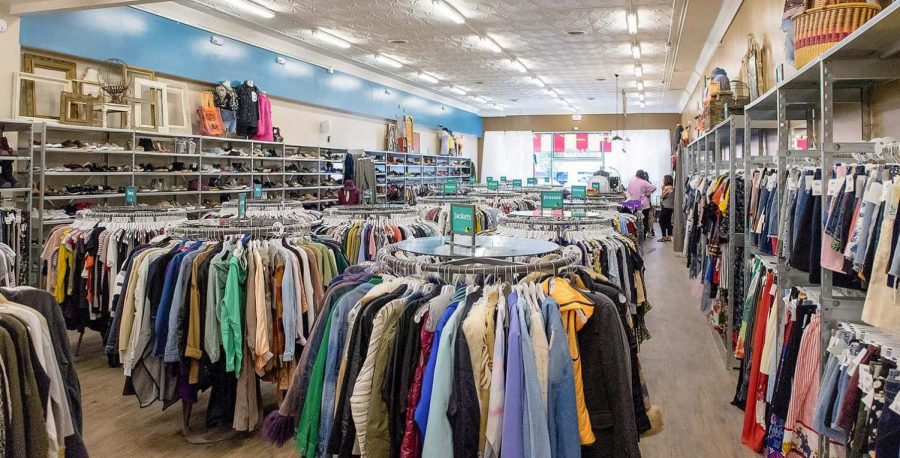Everyone Should be Thrifting and Reselling, Not Just Those in Need
November 14, 2020
The echo of a hundred voices talking over pop songs bounces around the food court of Northgate Mall in Terra Linda. Just past the food court and movie theater, dozens of stores, lit up with flashy bright signs and gripping displays, host customers for another day of shopping. One look into Pacsun and you will see a gaggle of teenagers looking around and trying on new, trendy clothes. However, they might not know that it takes over 700 gallons of water to produce one single cotton tee shirt.
“Fast fashion” is defined as clothing produced rapidly by mass-market retailers in response to the latest trends. Think big retail chains like H&M, Forever 21, and Old Navy. It is easy to see where the appeal comes from, as one can visit the website or go to the mall and buy trendy new clothes. Although some people don’t like the idea of buying clothes that have been previously worn, it is a truly unique experience to know that the clothes you are buying have a story behind them and are now getting a new chance at life. Another benefit of thrifting is that your wardrobe will be completely individual and customizable to your taste, instead of just the same short-lived trendy shirt everyone else has for two months before it goes out of style.
In the past decade, thrifting and sustainable shopping has taken on a completely new life in the United States, especially as environmental experts are beginning to call out fast fashion for the shocking amount of textile waste, carbon dioxide emissions, water pollution, and unsafe labor conditions and use of sweatshops that the industry requires. Thrifting has become a trend amongst Generation Z and millenials, and now more than ever people are beginning to embrace thrifting for its cheap and sustainable clothing.
However, it is a very widespread opinion that the rise of thrifting, and especially the act of reselling clothes on apps like Depop for a higher price are causing the prices at thrift stores to rise. Many people see this as an issue because as prices are rising, thrift stores are becoming gentrified and pushing poor people out. People are noticing that especially at chain secondhand stores, namely Goodwill, prices are becoming more and more ridiculous as thrifting becomes more popular. For example, one user posted on Reddit that they have noticed a “steep hike in prices” and many others have complained of the same issue at their local Goodwill stores. Goodwill actually put out a response for this, saying that reselling is not contributing to a price change, and that the money spent at their stores is put toward good use, including charities, youth programs, and veteran programs.
Local thrifter and Tamalpias High School senior Hannah Eigsti sees both sides of the argument. “There are a couple problems with thrifting to resell,” said Hannah. “The most important is off-season-shopping. For example, if it’s winter, buy summer clothes, and vice versa. This leaves the seasonal pieces for people who really need them.”
With the popularization of thrifting on social media, it is easy to think that the huge influx of shoppers are taking all of the inventory for themselves, resulting in those in need not being able to afford or find the items they need. However, in 2018, only 28% of people donated old clothes, while only 7% of people bought secondhand clothing. Although the faults of the fast fashion industry are becoming more talked about, fast fashion will unfortunately not disappear any time soon. As more people begin thrifting and stop buying fast fashion, the fashion industry will slowly become more sustainable and less harmful to the Earth.
This 21% difference in those donating clothes and those buying clothes means that the inventory at thrift stores, especially chains such as Goodwill, Salvation Army, and Buffalo Exchange always have a plentiful supply of clothing and items to be sold. In fact, so many clothes get donated that most of them get shipped off to foreign countries or sold to textile recycling firms at the end of the month. Some countries have begun to reject clothing as it actually robs locals of jobs and income. This means that when more people thrift, no matter their status, the more clothes are saved from ending up in landfills.
Another group of skeptics argue that thrifting for yourself is fine, but reselling on popular apps such as Depop is helping contribute to the rise in price. The truth is, whether you thrift for your personal wardrobe or are thrifting to resell, both are completely ethical. You’re ultimately taking away the amount of clothing being thrown out. The “stylish” clothing at thrift stores is not being thinned out by resellers because style is subjective and the amount of clothing at thrift stores is always abundant and being replenished. Reselling clothing found at thrift stores simply does not contribute to the reason why prices at some thrift stores are on the incline. Instead, that can be attributed to the corporations, not the consumers.
San Francisco Manager of Marketing at Goodwill Alex Hallmark had some words to share about reselling. She said, “I think reselling is a great option for low-income people to make money and when resellers buy in bulk from SF Goodwill for their inventory, they become great supporters of our nonprofit mission to create second chances for local people through training and the dignity of work.”
Overall, thrift shopping is beneficial for everyone: plus size people who can’t find their sizes at trendy stores, a variety of people who get income from reselling, workers, children, and veterans who receive benefits from Goodwill, people who now can buy a whole wardrobe for a good price, and more. Most of all, the Earth benefits as every day it suffers a little less when people opt for thrifting.






































